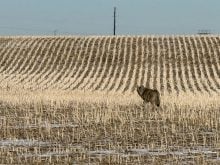Prairie farmers and ranchers are an optimistic lot.
After the initial shock of the door slamming shut to Canadian cattle exports in May 2003 following the discovery of BSE in Alberta, many sought to make the best of a bad situation.
Cut off from American feedlots and packers and with more cull cattle than existing Canadian packers could handle, producer groups and communities began plans to build slaughter plants. They would process more cattle at home and reduce the need to ship cattle south.
But bad situations can also get worse.
Read Also

Agritechnica Day 3: Hybrid drive for a combine, data standards keep up to tech change and tractors of the year
Agritechnica 2025 Day 3: Hybrid drive for a combine, data standards keep up to tech change and tractors of the year.
Rancher’s Beef in Alberta and Natural Valley in Saskatchewan are two examples of plants that were built, opened and failed, taking producer and lender money with them.
In Manitoba, equipment destined for Ranchers Choice, a plant proposed for Dauphin, lies outside in a pile.
And the slaughter sector isn’t alone.
Pulse processing plants came and went earlier this decade, seemingly overnight in some cases. Other ideas have met the same fate.
“The Prairies seem to be littered with good intentions,” said Jonathan Small, a farm management consultant with Meyers Norris Penny.
To be fair, there are success stories. Weyburn Inland Terminal is a long-standing example of a profitable business conceived, built and owned by farmers.
Newer projects are also thriving, such as Blue Hills Processing in Avonlea, Sask., still successful six years after opening at the same time other pulse facilities were closing.
Experts say there is no single reason why some businesses do well and others fail.
“We’re always going to see this,” said University of Saskatchewan agricultural economist Murray Fulton.
By the time Clark Sullivan’s phone rings, a business is in trouble. The Regina-based financial adviser, who often serves as a court-appointed monitor helping businesses restructure, sees a lot of the failures.
He points to three main things a successful business needs: the idea, or widget as he calls it; a management team “that can actually lead;” and cash flow.
“We’re pretty good at coming up with the idea,” Sullivan said of agricultural businesses.
“They’re not bad at managing. The main problem is underestimating the amount of capital it takes to build in the first place.”
There are always cost overruns, he said, and then the organizers don’t have enough money to cover start-up losses and develop markets.
The “if you build it they will come” mentality doesn’t work.
In the case of slaughter plants, Small said entrepreneurs often started at the wrong end of the supply chain.
The first thing most did was secure land to build plants, and the last thing they did was market research.
“In the execution, they did everything backward,” he said, adding that in his experience European farmers have donethe same thing.
Sylvain Charlebois, associate dean of the Johnson-Shoyama Graduate School of Public Policy at the universities of Regina and Saskatchewan, said projects often aren’t focused enough on demand.
“Producers are part of a commodity driven industry,” he said.
They are excellent producers and often have good ideas, but once they move into the food industry, they find stiff competition. Charlebois said they are uneducated and unaware of that reality.
“(Food) distributors are running the show,” he said. “Producers are making really great products but they don’t have access to the market.”
He said leadership within the business is key. Good leaders will think the business plan through to the end, while weak leaders don’t. Good leaders know when to work with others and call in the professionals.
“Great farmers are not necessarily great at the board room table,” Small said. “Human resources for farmers is a mine field.”
They might not have the experience needed to hire a competent leader, or don’t want to use outside professionals because that would mean giving up control.
Charlebois has examined the businesscase for Natural Valley, comprising the slaughter plant near Neudorf, Sask., and the processing facility at Wolseley, Sask.
He said the principals had researched their market and thought about supply and commitments. However, they underestimated the cost of complying with federal regulations. The lesson learned in this case is to start small and build up, he said.
But that doesn’t always work either. Fulton said many observers of the BSE situation recognized that once the disease was controlled and the border reopened, smaller plants would be “toast,” unable to compete against the pull of huge U.S. packers.
“They were too small to get the kind of economies of scale needed” to compete in the packing industry, he said.
Established, larger companies can also run into trouble.
The former farmer-owned co-operative Saskatchewan Wheat Pool, which embarked on an acquisition and building program in the 1990s and subsequently underwent wholesale restructuring, is an example of optimism gone awry.
Fulton, in an article recently published with Kathy Larson in Journal of Cooperatives, said overoptimism results from the way business plans are developed.
“Most business plans start with a proposal,” they wrote. “By their very nature, proposals accentuate the positive. However, starting with a proposal that is tilted toward the positive virtually ensures that the final plan shares the same tilt.”
Nobody faults farmers for their optimism.
“I don’t want to be too hard on them,” Fulton said.
Sometimes even the best laid plans can be sideswiped by the unexpected. For example, some new pulse processors couldn’t cope with two years of poor pulse crops.
“You need really good planning,” Fulton added.
“Take a cold hard look at everything that can go wrong.”















